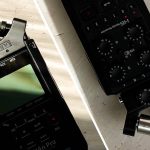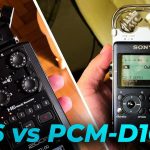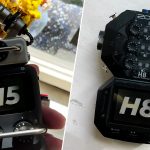Perhaps you’ve been dying to give these flying cameras a go, but you don’t know where to start? In this review, we’ll check out the pros and cons of the kindly-priced DJI Mavic Mini, including the Flymore Combo, but I’ll also show you what kind of footage you can get with it. If you’re any type of filmmaker, especially a YouTuber, you’re going to want to hear what I have to say about it.

Tiny and Lightweight
The Mavic Mini drone weighs a mere 249g, and there’s a reason for that.
The drone is made almost entirely of flexible plastic and would rival your cell phone in size. Honestly, you could fit the drone in a decent-sized pocket without too much trouble. In fact, it fits tightly in a tiny pocket inside of my camera bag.
The reason for this drone’s minuscule weight is that DJI have done everything in their power to keep the weight under the usual regulation thresholds.
Drones weighing less than 250g are usually exempt from many flying regulations that govern heavier models. So, the Mavic Mini even has 249g printed on its side, to leave you in no doubt on which side of the weight barrier it falls.
With that in mind, you should always double-check the rules when it comes to flying drones in your area.
If you get the Fly More Combo kit, which I recommend, they give you a small carrying case for it, but I prefer to carry it in my Lowepro ProTactic 450 AWII, as it takes up less space that way, and I don’t have to worry about a second bag.
Props
The eight tiny propellers (two for each arm) are made of flexible plastic and feel reasonably secure. DJI supplies four extra blades in the box as well as a few screws and a screwdriver so that you can make some running repairs, at least the first time you need to.
Fold the arms out from the body so that they click into place, check the screws and that’s it. They’re ready to fly.
PS: If you get the Fly More Combo kit, you get extra propellers and such.
Windy Weather
One downside of the weight-cutting measures means that the Mavic Mini is not weatherproof, so it’s really a fine-weather machine.
You need to be aware of the conditions at higher altitudes as well. It might be calm where you’re standing, but gusty where you’re flying the drone. It’s so light that the wind can easily blow it off course or force a crash landing.
Even without the possibility of damaging your drone, you simply can’t get smooth video footage or crisp photos when your camera is swinging and swaying in midair.
Controller
The Mavic Mini has a remote controller that’s about the same size as the drone itself.
There is no LCD, so you need to connect your phone to provide a screen and to run the software. DJI provides you with multiple kinds of cables, in order to make sure that you can indeed connect your phone.
On the controller you’ll find two fold-out antennae, two clamps to hold your phone and two joysticks to control the drone in flight. When you’re travelling, the joysticks can be detached and stored inside the controller so that everything folds up neatly in a compact package.
I suggest that you double-check the size of your mobile phone before you buy a Mavic Mini. The manual recommends mobiles that are 6.5-8.5mm thick and no more than 160mm long. If your device is outside those dimensions, it may not fit into the controller clamps.
I operate it using my iPhone 6s Plus, which is quite a big boy, and it just about fits.
Range
DJI’s claims 4km HD video transmission back to your phone, which sounds like a pretty good range for something so tiny.
In reality, you’re likely to get that range out in the countryside, but not in a built-up, urban area. Unfortunately, the WiFi tends to break up a little, and you could get some signal loss in town. It may not be much, but it’s likely to make your urban footage seem a little jerky.
But, when you take the drone out into the country, there is considerably less interference, and that virtually eliminates the signal loss problems.
I’d say this is not really an issue, as most cities, or built up areas have loads of prohibitive laws around flying drones, and so they’re best avoided anyway. And besides, I really would not recommend being 4km away from your drone, especially not in an urban area.
Gimbal
Tucked under the aircraft nose, we find the camera, protected by a strong, clear case and attached to a gimbal with a 3-way axis.
The gimbal allows rotation in all three dimensions, pitch, roll and yaw. What that means is your camera will move up and down, side to side and turn. The turning is so that you can get level footage when moving sideways. Remember, the drone has to tilt in order to move sideways, and the gimbal compensates for this, thus giving you even footage.
Drone Sensors
One thing the Mavic Mini lacks is object avoidance sensors, so you need to be aware of all the environmental hazards in the area. It’s a bit of a lack in a drone so clearly aimed at beginners.
The drone does have downward sensors, though, which help it to land safely at the end of its flight. It also has an automatic return to home function, which is handy if you lose sight of the drone. Not much help if you crash it miles from home, however, because it’s easy to lose a drone. Even when it lands within your line of sight, you can search for hours and keep missing the aircraft if it’s buried in vegetation.
To help with that, the Mavic Mini has a “find my drone” feature. First, your phone screen shows the flight line, so you know which way to walk or drive. Then, if you activate “find my drone” when you’re getting close, the aircraft will beep and flash its lights. Much easier to find, even stuck in a tree or buried in undergrowth.
Camera
At first glance, you might think that the camera’s 2.7k resolution isn’t much. Most modern phones give you far more than that.
But the photos and videos from the 1 / 2.3-inch CMOS sensor come out crisp and clear.
The camera doesn’t have zoom capability, but it’s excellent for taking scenic, high-angle photos and panoramic videos. However, if you want a closer shot, you’ll need to move the drone accordingly.
Photo Format and Storage
Mavic Mini is all about being small and sharp, and that comes with some compromise in the features it offers. One is that the camera only uses the jpeg format.
It also doesn’t have internal storage but does take a microSD card. You can then simply connect the drone to your laptop via a USB cable and transfer the files over. Alternatively, you can pop the card out, insert it into a microSD card reader, and transfer the files that way.
Battery
The Mavic Mini uses a Li-ion 2S battery which gives up to 30 minutes flight time. More realistically, the actual flight time depends on weather conditions, and you’re more likely to get 20-25 minutes out of the battery. Another thing to bear in mind is that you get even less if you want to budget time for the drone to return to you safely, before running out of juice.
To be clear, this is something you absolutely want to do, unless you’re happy to lose your drone.
Even with that in mind, that’s an incredible amount of time for such a tiny machine that flies and takes photos and video.
You can recharge the drone by connecting it directly to a charger with a micro USB cable. That takes around 90 minutes, which could be a frustrating amount of time to wait.
This is the main reason why you want to get the Fly More Combo kit. It’s an absolute must, as it provides you with a few extra goodies, including 2 extra batteries, and a two-way charging deck. This massively expands your flying time, and it’s something that I can’t recommend enough.
Not only can you charge the batteries inside the deck, but you can also use the juice inside the batteries to charge your phone when in a pinch.
DJI Fly App
The Mavic Mini can only be used with the DJI Fly App, which you can find in the app store or from the QR code on the DJI website. This software not only gives you the controls to operate the drone and camera but also includes tutorials to help you learn as you fly.
The app includes four QuickShot modes, Dronie, Circle, Helix and Rocket. Each mode gives you a different movement and viewpoint when videoing. It only works in auto exposure mode, but there are workarounds. You can use the AE lock which provides you with control much like a manual mode would.
The DJI Fly App also has a handy search function which lets you discover nearby Fly Spots and GEO zones. And, if you do need permission to fly in a particular zone, you can apply for that on the app as well.
Lastly, the app includes an editing function too, with tools and templates for editing and sharing your photos and videos. If you’re serious about your work, you’re probably going to want to unload your footage, and drop it into Premiere first, but it’s good to know that this is an option as well.
Image Quality
Now that I’ve covered a lot of the technical aspects of this camera, it’s time to show off some of what it can do in cinematic mode. There’s obviously also sports mode and such, but since this website is targeted at YouTubers and filmmakers, Cinematic Mode is what we’ll focus on.
I’m currently visiting family in Romania, and I’ve been spending some time in my home town. As a result, I’ve put together a short montage using this drone. If you just want to see the footage, feel free to skip to 06:15.

Japanese and International Models
The Mavic Mini caters to the Japanese market by producing an even lighter model, which weighs a mere 199g. In Japan, drones under 200g are not subject to Japanese drone flight rules.
The Japanese version uses a different battery to achieve this lighter weight, so double-check model numbers before you buy your drone and its spare parts.
Conclusion
All in all, the Mavic Mini is an affordable mini drone which takes astonishingly good-quality photos and videos. It has easy-to-use controls and tutorials through the DJI Fly App.
It’s compact enough to fit in your jacket pocket or to tuck away in a camera bag, which makes it perfect as a travel drone, especially if you’re a YouTuber. The downside of the minuscule weight, however, is you can’t take it out in windy or inclement weather.
The small size comes with compromises such as no object avoidance measures and sensor size but not in photo quality or manoeuvrability. All in all, if you want to buy your first drone, the Mavic Mini could easily be the perfect flying camera for you.
Thank you for taking the time to read our article on the DJI Mavic Mini. I invite you to have a look at some of my other articles. We have something for everyone, whether you’re interested in audio, or cameras and lenses. Alternatively, if you prefer video reviews, feel free to have a look at my YouTube channel.



